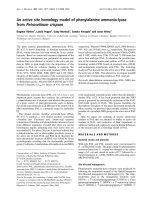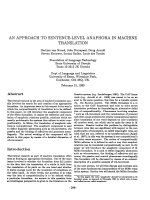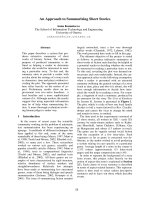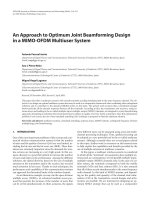Báo cáo y học: " An issue to remember" ppt
Bạn đang xem bản rút gọn của tài liệu. Xem và tải ngay bản đầy đủ của tài liệu tại đây (142.97 KB, 2 trang )
Petsko: Genome Biology 2009, 10:111
Even by that journal’s lofty (and frequently self-proclaimed)
standards, the 3 September 2009 issue of Nature is likely
to be regarded as one of the most memorable in years.
Many issues of a general journal have at least one thing in
them that is of interest to each reader, but in this case it
could be argued that almost everything in this issue is
likely to be of interest to practically everybody. Anyone
wishing to present evidence of the health of the global
scientific enterprise could probably just hold up a copy and
then sit down.
Nanotechnology is a field that has sometimes been charac-
terized by more hype than results, but the paper from
Nadrian Seeman’s lab on page 74 is worthy of all the
attention it is likely to attract. It reports the design and
synthesis of a triangle of three DNA helices that self-
assembles into a three-dimensional periodic array. The
authors then prove that the array has the intended struc-
ture by crystallizing it and determining its atomic
arrangement at 4 Å resolution. As far as I know, this is the
first time a well-ordered macromolecular three-dimen-
sional crystalline lattice has been designed and successfully
assembled. It opens up the possibility of manufacturing a
wealth of nanoscale objects from the stuff that make up the
genome, including templates on which other nanoparticles
can be assembled. A disclaimer is in order here: Ned
Seeman, who is one of the pioneers of biomaterials nano-
technology, has been one of my closest friends for 35 years.
I remember when he first described his plans to do this
project, over 25 years ago, so this paper is the culmination
of more than two decades of effort. But he needs no special
favors from me to publicize this work; it is a landmark
achievement and if you read nothing else in the article, you
should read the last paragraph, in which Ned outlines the
possible applications of this technology. It presents a
mind-blowing view of a future in which nanoscale fabrica-
tion can be done with a precision and versatility that
seemed like science fiction not that long ago.
Then there are three papers that represent structural biology
at its best, using structure to unveil the details of important
cellular mechanisms at the atomic level. They provide the
solution of the three-dimensional structure of a mechano-
sensitive ion channel in its intermediate state, and new
insights into the mechanism of action of the molecular
motor kinesin, and into the export of tRNA, respectively.
In an era when the mindless grinding out of hundreds of
structures of proteins of no known function in structural
genomics is considered exciting big science and is lavished
with support, work such as this reminds us that what
structural biologists should be doing is picking important
problems and using the power of their technology to probe
how things work.
The papers noted so far are enough to make any issue of
any journal worth reading, but I haven’t even scratched the
surface of this one. I will skip over fascinating papers on
the molecular basis of the evolution of the heart chamber,
and the discovery, in the Andromeda galaxy, of stars and
coherent structures that are likely to be the remnants of
dwarf galaxies destroyed by the tidal field of this giant one.
Two papers stand out as being truly historic. They
represent the first reports of the generation of fertile adult
mice from induced pluripotent stem cells (iPS cells).
iPS cells are to stem-cell biology what the polymerase
chain reaction (PCR) was to cloning. Before PCR, cloning a
gene was a hit-or-miss proposition requiring years of work.
After PCR, anybody could clone almost anything. Until
recently, stem-cell biology was hostage to the technical
difficulty, and ethical quagmire, of producing human
embry onic stem cells (human ES cells) from human
blastocysts. Shinya Yamanaka and his graduate student
Katzutoshi Takahashi, from Kyoto University in Japan,
changed all that in 2006 when they reported the creation
of what they called ‘induced pluripotent stem cells’. iPS
cells could be generated from a wide variety of differ en-
tiated mammalian cells (typically skin cells) by transfection
with just four genetic factors. Numerous studies by
Yamanaka (who as far as I’m concerned should start
booking his flight to Stockholm now to ensure a good seat)
and by other workers have confirmed that iPS cells
resemble ES cells in morphology, gene-expression profiles,
proteomic profile and the epigenetic status of several
pluripotency markers. They can also differentiate into a
wide variety of specialized cells. But it had not been shown
that they could generate viable adult animals.
Until now. On pages 86 and 91 of the 3 September issue of
Nature, Qi Zhou’s and Fanyi Zeng’s groups in Beijing and
Comment
An issue to remember
Gregory A Petsko
Address: Rosenstiel Basic Medical Sciences Research Center, Brandeis University, Waltham, MA 02454-9110, USA.
Email:
111.2
Petsko: Genome Biology 2009, 10:111
Shanghai, and Kristin Baldwin and Kristopher Nazor’s
groups at the Scripps Institute in La Jolla, California,
respectively, report the successful generation of healthy,
fertile adult mice from iPS cells through tetraploid comple-
mentation. A similar result was achieved simultaneously
by Shaorong Gao’s group at the National Institute of
Biological Sciences in Beijing, and was published in the
7 August, 2009 issue of Cell Stem Cell. These data prove
conclusively that iPS cells are truly pluripotent and that
reprogramming differentiated cells with just the four
‘Yamanaka factors’ can recapitulate the reprogramming
capacity of the oocyte.
So it’s been done three times, and if it can be done three
times it can be done a thousand times, and it certainly will
be. iPS cells are going to change the shape of the biomedical
world. In my view, all our existing cell-culture models of
disease, many of which are generated with inappropriate
cell types such as tumor cell lines, need to be re-evaluated
in the light of what iPS cells can do. Given the ability to
make pluripotent stem cells from easily obtainable cells of
a patient with just about any disease, and the relative ease
with which those iPS cells can be converted into neurons or
liver cells or just about any cell that is needed, the
likelihood is that we are on the cusp of a revolution in how
we study a host of processes in living organisms.
But I have to say that none of the papers I’ve talked about
so far is my favorite (sorry, Ned). On page 53 of this
remarkable issue is the one I enjoyed the most: ‘Early-
warning signals for critical transitions’ by Marten Scheffer
at Wageningen University in the Netherlands and a host of
colleagues from other countries. This paper lays out a set of
critical signs that a complex system - whether the climate,
the brain circuitry of an epileptic, or the financial markets -
is about to undergo a dramatic shift from one state to
another. If the financial ‘masters of the Universe’ had only
been able to read this paper before the recent financial
crisis - well, OK, being a bunch of greedy morons they
probably wouldn’t have understood it and almost certainly
wouldn’t have paid attention to it even if they had. Still, for
anyone who wants to see when something big is about to
happen, the paper is riveting. The authors develop a
mathematical model of transitions that provides support
for their conclusions, but their essential concepts are easily
understood in non-mathematical terms. Basically, systems
about to undergo significant transitions experience critical
slowing down, increased asymmetry of fluctuations
(‘skewness’), oscillation between two substates (‘flickering’),
and the appearance of particular spatial patterns. The
authors go on to show that these early-warning signals can
predict the onset of transitions in people prone to
asthmatic and epileptic seizures, the end of glacial periods,
changes in direction of the financial markets, and a
number of other real-world applications.
Obviously, I really enjoyed reading this issue of Nature,
and the point I now want to make is that I wouldn’t have
read it at all if I hadn’t happened to read it. Let me explain.
I knew that Ned had an important paper coming out soon,
so I scanned the table of contents of each issue of Nature
for a couple of weeks. That in turn caused me to notice the
papers by Zhou and Steffen and all the others. But had I
instead searched for Ned’s paper online, I would have
missed them. True, I might have found the iPS cell papers
eventually because I am interested in that topic, but I never
would have read the early-warning signal paper, or the
tRNA export factor paper, or most of the other papers I’ve
talked about here.
Picking up a copy of a journal and thumbing through it -
browsing, as we used to call it - has gone out of fashion
with the advent of electronic databases and searching the
literature with Google or PubMed. That may be more
efficient but it’s a lot less fun. Creativity is the art of the
unexpected, of putting disparate facts together, of connect-
ing the dots between two fields where connections are not
known to exist. The more precise our searching, the more
specialized our knowledge, the less chance there is of the
happy accident from which new ideas almost always spring.
In the rush to do away with paper copies of journals and
move towards all-online publication (like this journal), we
are in danger of forgetting the importance of finding ways
to keep browsing alive. As long as paper copies of journals
exist, I will try to find the time to flip through them, hoping
for that happy accident. Precise searching within the
confines of one’s field certainly helps to create experts, but
I am willing to bet that those who arrange their intellectual
lives so that they only find what they are looking for will
forever work for those who browse.
Published: 29 September 2009
doi:10.1186/gb-2009-10-9-111
© 2009 BioMed Central Ltd









